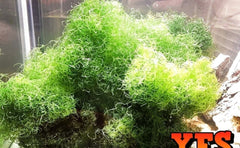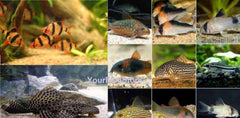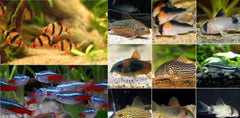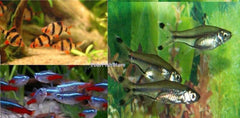Dragon Wrasse - Adult Approx 2 - 3" - Novaculichthys Taeniours

Thank You for shopping with YourFishStore. Our primary concern is the health and safety of your fish. To achieve this standard, we professionally package all aquatic life in the best materials and use the most direct and reliable shipping method which is FedEx Overnight.
Our fish come from distributors who have already acclimated the fish to aquarium conditions after arrival from around the world. Fish are then hand-picked and prepared for shipment to you. Fish are packaged in properly conditioned saltwater with correct pH levels in heavy-duty poly bags to cushion and protect. Each bag is filled with oxygen for optimal conditions and secured by a professional bag sealing technology. The water and airtight bags are then housed in Styrofoam coolers along with a heat or ice pack, as seasonal conditions dictate.
Shipping Day: Wednesday Every Week, For Thursday Arrival
Shipping Method: FedEx Overnight Priority
Materials Used: An insulated box and heat/cool packs (according to ambient temperatures) will keep the fish comfortable until they arrive to you.
In the case of “Dead on Arrival” you must .
*********************************************************************
DRAGON WRASSE - ADULT APPROX 2 - 3" - NOVACULICHTHYS TAENIOURS FREE SHIPPING
Minimum Tank Size: 100 gallons
Care Level: Moderate
Temperament: Semi-aggressive
Reef Compatible: No
Water Conditions: 72-78° F, dKH 8-12, pH 8.1-8.4, sg 1.020-1.025
Max. Size: 1'5"
The dragon wrasse is somewhat of a cosmopolitan of the Indo-Pacific. It is known to occur from the east coast of Africa and the Red Sea all the way to the Hawaiian Islands (where many are collected) and the coast of Panama (including the islands off the west coast of the Americas) and the Gulf of California. It occurs as far north as the southern islands of Japan (the Ryukus) to Lord Howe Island and New South Wales, Australia, in the south.
The dragon wrasse aquarium should include plenty of rubble for the fish to move around the tank. It may also flip over fungiid corals and coral frags that are not attached to the rockwork. A larger juvenile is shown here.
One finds the dragon wrasse on both coral and rocky reefs. It is found in protected lagoons, near the edges of reef faces over sand and rubble bottoms, and on sand and rubble slopes. Over parts of its range, the juveniles also live in seagrass beds. The dragon wrasse tends to be a resident of relatively shallow depths, having been recorded from depths of less than 1 foot to 70 feet.
Both juveniles and adult N. taeniourus are solitary fish. When it comes to its social life, data is lacking, but it is probably similar to other members of the razorfish group; in this group, males defend a larger territory that contains the smaller territories or home ranges of a group of female dragon wrasse mates.
The spawning behavior of dragon wrasses has been observed in the wild. Males and females are similar in coloration and nearly equal in size. They court for five to 10 minutes; during such sessions, the male, with his fins spread, will circle a prospective female. The male then rises into the water column, followed by the female until they are side-by-side. They continue to rise slowly and release their gametes into the water column at the top of this ascent.
The spherical eggs are 0.59 millimeters in diameter and contain an oil droplet that makes them buoyant (they are pelagic). The wide geographical distribution of the dragon wrasse may be a function of the duration of the larval phase. The larvae float about in the pelagic zone and are at the mercy of ocean currents for about 75 days. This is a particularly long larval phase for a wrasse.
The juveniles engage in what would best be considered a masquerade – they impersonate drifting pieces of algae. The young fish is flattened laterally, having long pelvic fins and elongate dorsal fin filaments. The fin rays are dark in color, while the membrane is clear, giving the body an even more frilly or filamented appearance. Along with the variegated white, black and reddish-brown or dark green coloration, these embellishments facilitate its likeness to plant material. They not only look like plants, they also behave in a way that enhances this resemblance. They undulate, drift and dip as they move just over the seafloor. It is thought that by resembling botanical flotsam, the juvenile dragon wrasse is less likely to attract the attention of roving piscivores.
If a predator does approach, the dragon wrasse exhibits another interesting behavioral trait. It will dive head-first into the soft sand. Now you see it, now you don’t! Not only does the dragon wrasse disappear under the sand, the little fish can undulate its body when buried to actually relocate when submerged. In this way, it can pop out in another location, just in case the predator remains in the area, waiting for the dragon wrasse to re-emerge.
As the dragon wrasse grows, its colors and fin appendages are transformed (the juveniles were once thought to be a distinct species, which was referred to as Novaculichthys bifer). The filaments shrink, and the mottling becomes more of an organized honeycomb pattern of gray spots on a dark body. The head turns gray overall, and the tail becomes white with a black band at the rear edge. This fish is a medium-sized wrasse, reaching a maximum length of around 10.5 inches.
QUESTIONS & ANSWERS
Have a Question?
Be the first to ask a question about this.














